- News
- Reviews
- Bikes
- Accessories
- Accessories - misc
- Computer mounts
- Bags
- Bar ends
- Bike bags & cases
- Bottle cages
- Bottles
- Cameras
- Car racks
- Child seats
- Computers
- Glasses
- GPS units
- Helmets
- Lights - front
- Lights - rear
- Lights - sets
- Locks
- Mirrors
- Mudguards
- Racks
- Pumps & CO2 inflators
- Puncture kits
- Reflectives
- Smart watches
- Stands and racks
- Trailers
- Clothing
- Components
- Bar tape & grips
- Bottom brackets
- Brake & gear cables
- Brake & STI levers
- Brake pads & spares
- Brakes
- Cassettes & freewheels
- Chains
- Chainsets & chainrings
- Derailleurs - front
- Derailleurs - rear
- Forks
- Gear levers & shifters
- Groupsets
- Handlebars & extensions
- Headsets
- Hubs
- Inner tubes
- Pedals
- Quick releases & skewers
- Saddles
- Seatposts
- Stems
- Wheels
- Tyres
- Health, fitness and nutrition
- Tools and workshop
- Miscellaneous
- Tubeless valves
- Buyers Guides
- Features
- Forum
- Recommends
- Podcast
review
£1,350.00
VERDICT:
Excellent fast flat-bar road bike with awesome performance, fantastic spec and great price
Weight:
9,670g
Contact:
At road.cc every product is thoroughly tested for as long as it takes to get a proper insight into how well it works. Our reviewers are experienced cyclists that we trust to be objective. While we strive to ensure that opinions expressed are backed up by facts, reviews are by their nature an informed opinion, not a definitive verdict. We don't intentionally try to break anything (except locks) but we do try to look for weak points in any design. The overall score is not just an average of the other scores: it reflects both a product's function and value – with value determined by how a product compares with items of similar spec, quality, and price.
What the road.cc scores meanGood scores are more common than bad, because fortunately good products are more common than bad.
- Exceptional
- Excellent
- Very Good
- Good
- Quite good
- Average
- Not so good
- Poor
- Bad
- Appalling
The Merida Speeder 900 lives up to its name as a supremely fast and efficient flat-bar road bike. The combination of its smooth and eager ride, impressive Shimano Ultegra spec and excellent Deore hydraulic disc brakes means that it's a whole lot of fun and not short on quality.
- Pros: Fab all-round performance, impressive spec, perfect for giving roadies a fright at the lights
- Cons: Maxxis Detonator tyres are rubbish in the wet
Because I spend much of my time testing commuter and flat-bar bikes, I generally hop aboard with flat mountain bike shoes and flat pedals rather than going down the route of clipping in. However, even in this rawest of states, the sheer speed and efficiency lurking within the Speeder 900 is hard to ignore. This is a very fast bike.
> Find your nearest dealer here
But more than just excellent straight-line speed and effective power transfer – so good, in fact, that I managed to rather upset a Lycra-clad roadie on a training ride – the Speeder's frame and fork offer a very enjoyable and involving ride experience. Front-end control at low and high speeds is fantastically accurate, which makes for a fun time in the saddle. It's so well balanced, in fact, that it really does feel like a well-sorted drop-bar road bike.
Once up to speed, cruising and descending can be kept relatively calm, though. I'll come to tyre choice later, but in wintry conditions I've have a few close calls with grip that's gone MIA, but the Speeder never seems to overreact. Because you can't get quite as low as on a drop-bar model, coming downhill on any flat-bar bike never seems quite as invigorating, but this is about as good as it gets with that compromise.
Perhaps the biggest surprise was with climbing. Going uphill is not my natural forte and I've discovered that I'm allergic (sweats, difficulty breathing, etc) to anything over about 5%, but the Speeder offers as much fun going uphill as any flat-bar bike I've tested. It's agile and stable enough to be flung around out of the saddle, and every pedal stroke seems to be returned with the expected amount of forward and upward momentum.
Frame
Without doubt, the heart of the Speeder's excellence is its classy – and obviously very road-orientated – 6066 aluminium frame. It's not just in performance terms that its quality is to be found. With a smart if perhaps slightly passé gloss finish and all-round internal cable routing – including through-fork routing for the front brake – there's little to complain about with aesthetics. Tubes are a mixture of shapes, although the rear triangle is round tubed throughout and a particularly pleasing study in svelte-ness.
Geometry is on the money, too. The long-ish wheelbase and slacker head tube accounts for the Speeder's stability, while the tapered steerer and carbon fork contribute to that direct front-end control. Reach/positioning is particularly good, with a slightly more stretched-out feel than on most hybrid-style bikes, meaning just a little more head-down enthusiasm.
If you'd be thinking of using it as a commuting bike, though, there is at least one speccing issue to take notice of: no rear rack mounts. With a rucksack-shod rider, it would be a fast light commuting machine, and for some reason the carbon fork features rack mounts if you want bags up front. But if you have ideas of fitting panniers you'll have to think again, which is a bit of a shame. On the upside, it will accept up to 37mm tyres or 32mm tyres if you want to take advantage of the mudguard mounts.
Groupset
The frame and fork's fast road bike tendencies are certainly not hindered by the groupset. If you've got complaints about Shimano Ultegra then you've been spoilt. Shifting is light, fast and accurate, and the choice of compact 50/34t chainset with an 11-32t cassette gives plenty of top-end speed with enough options lower down to get up most climbs.
Braking is equally secure, with Shimano MT-500 (Deore) hydraulic disc brakes taking good care of stopping duties. As I mentioned, I've been testing this bike in fairly inclement conditions and even with less-than-grippy tyres, these brakes have offered good overall power. More importantly, they provide really effective modulation, so you can adjust your braking input to best match the available traction.
Wheels
If I was really splitting hairs, I suppose the own-brand wheels could be seen as an example of slight under-speccing. In action, though, they don't hinder the ride experience. While the Joytech hubs and own-branded rims aren't the last word in performance, and they certainly can't match fellow Taiwanese manufacturer Giant's own-brand hoops, they roll well enough and even look quite sexy with their 28-spoke lacing.
However, there is one definite area of criticism: tyres. Initially, I was quite excited by the 32mm Maxxis Detonators. Because they can be pumped up to 100psi, it means you have exactly the same contact patch with the road as skinnier tyres at 100psi, yet enjoy just a little more comfort.
On dry roads, they are excellent. But with a bit of dampness on the floor, and maybe some slidey surface mulch, you'll want to swap to something with a bit more bite because these lose grip very quickly in poor conditions.
Components
Rounding out the package is the sort of finishing kit you'd expect to see on a decent mainstream road bike: alloy stem, seatpost and handlebar. The 600mm bar and Merida Expert EC grips are interesting only insofar as they have left very little impression on me, which means they do their job adequately well.
More memorable is the Merida Comp SL saddle, which looks suitably svelte and serious but offers just a little bit of cushioning. For experienced riders, it will hold no concerns and suits the speedy nature of the Speeder far more than some over-stuffed leisure bike pillow.
Value and conclusion
We haven't tested many bikes at this end of the flat-bar market although Specialized does have a £1,400 carbon-framed model in its Sirrus hybrid range (I tested the £425 alloy model last year), but, as you'd expect considering its carbon frame, the spec on that is otherwise noticeably down on the Speeder 900.
> Buyer's Guide: 6 of the best new-generation hybrids
Considering the Speeder 900's zest for speed, perhaps more apt comparisons lie among drop-bar road bikes. Jon at off.road.cc loved the £1,399 Ribble CGR AL Shimano 105 and thought it was great value, which reflects very well on the Speeder 900 and its Ultegra setup. The same is even more true when compared to another drop-bar all-rounder we liked, the £1,325 Forme Monyash 1 with its Tiagra drivetrain. Against the background of bikes like that, the Speeder looks very good value indeed.
> Buyer's Guide: 22 of the best commuting bikes
In fact, you don't need to do much research to understand just how good a bike the Speeder 900 is: one ride should be more than enough. With its fantastic power delivery, handling, overall enthusiasm – and not forgetting its very decent drivetrain and brakeset – this really is a bike that delivers on the road. It does pose one question, though: who needs drop bars?
Verdict
Excellent fast flat-bar road bike with awesome performance, fantastic spec and great price
road.cc test report
Make and model: Merida Speeder 900
Size tested: Large
About the bike
List the components used to build up the bike.
Merida lists:
Frame: 6066 aluminium Merida Speeder Lite II
Fork: Carbon tapered Merida Speeder CF2
Front derailleur: Shimano Ultegra
Rear derailleur: Shimano Ultegra
Levers: Shimano SL-RS700 (105)
Chainset: Shimano Ultegra 50-34t
Cassette: Shimano CS-R7000 11-speed 11-32t
Bottom bracket: Shimano BB-RS500 BSA
Brakes: Shimano MT500 (Deore) hydraulic discs
Hubs: Joytech
Rims: Merida Expert SL
Tyres: Maxxis Detonator 32mm
Stem: Merida Expert CC aluminium
Handlebar: Merida Expert CC aluminium 600mm
Grips: Merida Expert EC
Seatpost: Merida Expert CC aluminium
Saddle: Merida Comp SL
Tell us what the bike is for and who it's aimed at. What do the manufacturers say about it? How does that compare to your own feelings about the bike?
This is a fast flat-bar road bike aimed at serious leisure riders or commuters. Merida says: "The Speeder has become more sporty. By increasing the length of the top tube, we have achieved a slightly longer reach which offers the rider a more sportive riding position while still being on the comfortable side. Furthermore, this geometry change leads to a longer wheelbase, which has a positive effect on directional stability and in combination with the slightly slacker head tube angle, improves the riding stability at speed."
Where does this model sit in the range? Tell us briefly about the cheaper options and the more expensive options
The Speeder 900 sits at the very top of the range, which starts with the Speeder 100 with its entry-level Shimano Acera drivetrain and progresses through the Speeder 200, 300, 400, 500 and Speeder Limited with its SRAM Apex 1x setup.
Frame and fork
Overall rating for frame and fork
9/10
Tell us about the build quality and finish of the frame and fork?
Very well made frame and fork with nice details such as internal cable routing and a smart if slightly old-school glossy finish.
Tell us about the materials used in the frame and fork?
6066 aluminium for the frame, carbon for the fork.
Tell us about the geometry of the frame and fork?
Compared to some road bikes, the Speeder has a long wheelbase and slightly more relaxed head tube angle. However, compared to leisure hybrids, it's still a fairly sporty proposition with a lower, more stretched out riding position.
How was the bike in terms of height and reach? How did it compare to other bikes of the same stated size?
Reach for me was particularly good – I have relatively long torso, so top tube lengths can feel a bit short, but this was perfect.
Riding the bike
Was the bike comfortable to ride? Tell us how you felt about the ride quality.
Yes, surprisingly so. It takes the edge off of rough surfaces well and deals with bigger bumps without crashing.
Did the bike feel stiff in the right places? Did any part of the bike feel too stiff or too flexible?
I'd say it was about as stiff as you'd want a bike like this to feel – there's no sense of unwanted flex.
How did the bike transfer power? Did it feel efficient?
This is one of the most efficient flat-bar bikes I've tested. It felt like all my effort was being used effectively.
Was there any toe-clip overlap with the front wheel? If so was it a problem?
No.
How would you describe the steering? Was it lively neutral or unresponsive? Quite lively.
Tell us some more about the handling. How did the bike feel overall? Did it do particular things well or badly?
I really enjoyed the bike's handling. Nice and direct, although not so twitchy to be tiresome at speed.
Which components had the most effect (good or bad) on the bike's comfort? would you recommend any changes?
Saddle is quite a nice combination of road bike-style shape with a bit of give, but probably the 32mm tyres had the biggest effect on overall cushioning.
Which components had the most effect (good or bad) on the bike's stiffness? would you recommend any changes?
Frame and fork are most responsible for the good balance of stiffness.
Which components had the most effect (good or bad) on the bike's efficiency? would you recommend any changes?
The frameset should take most of the plaudits, although the Shimano Ultegra drivetrain is a beauty, too!
Rate the bike for efficiency of power transfer:
9/10
Fantastic power transfer.
Rate the bike for acceleration:
9/10
It's a lot of fun getting up to speed.
Rate the bike for sprinting:
8/10
Because of positioning it's not quite as good as a drop-bar for sprinting, but still enjoyable to chuck around.
Rate the bike for high speed stability:
9/10
This is a bike that loves to be ridden at speed.
Rate the bike for cruising speed stability:
9/10
Cruising is worry-free.
Rate the bike for low speed stability:
9/10
Direct and lively at low speed but no sense of instability.
Rate the bike for flat cornering:
9/10
Easy to manoeuvre.
Rate the bike for cornering on descents:
9/10
Really attacks corners with confidence.
Rate the bike for climbing:
9/10
One of the highlights for me was how good the Speeder is on climbs – very rewarding.
The drivetrain
Rate the drivetrain for performance:
9/10
There's very little to complain about with Ultegra – it's a great drivetrain.
Rate the drivetrain for durability:
9/10
Will last.
Rate the drivetrain for weight:
9/10
Tell us some more about the drivetrain. Anything you particularly did or didn't like? Any components which didn't work well together?
Ultegra is a fantastic option and, in this situation, proves it doesn't have to be the preserve of drop-bar bikes only!
Wheels and tyres
Rate the wheels for performance:
7/10
Good enough.
Rate the wheels for durability:
8/10
Should last well – they look sturdy and have happily dealt with difficult roads so far.
Rate the wheels for weight:
6/10
Compared with the rest of the Speeder 900 package, they're not the lightest ingredient.
Rate the wheels for comfort:
8/10
Very good.
Tell us some more about the wheels.Did they work well in the conditions you encountered? Would you change the wheels? If so what for?
Good enough wheels, although possibly the weakest part of the Speeder 900's build. At this kind of price point you're just entering the area of the market where third party brand wheels might be specced, so possibly these are a slight disappointment. That said, they do their job without letting down the rest of the bike.
Rate the tyres for performance:
7/10
Great on dry roads, pretty hairy on wet roads.
Rate the tyres for durability:
8/10
No problems so far.
Rate the tyres for weight:
7/10
OK.
Rate the tyres for comfort:
9/10
Very good – lots of cushioning.
Tell us some more about the tyres. Did they work well in the conditions you encountered? Would you change the tyres? If so what for?
Had I been testing the Speeder at the height of summer, I'd have little to complain about with the Detonators. But I tested it in winter, which showed up their lack of grip on soggy and slimy surfaces.
Controls
Rate the controls for performance:
7/10
All felt good.
Rate the controls for durability:
7/10
Standard alloy kit.
Rate the controls for weight:
7/10
As expected.
Rate the controls for comfort:
8/10
Saddle and grips are actually pretty good.
Tell us some more about the controls. Any particularly good or bad components? How would the controls work for larger or smaller riders?
It's all standard own-brand alloy kit. Like the wheels, some manufacturers might spec something a bit more exciting, but in performance terms, there's nothing to criticise.
Anything else you want to say about the componentry? Comment on any other components (good or bad)
Overall, the most important parts of the componentry – the Ultegra drivetrain and the Shimano MT500 hydraulic disc brakes – are really fantastic.
Your summary
Did you enjoy riding the bike? Yes
Would you consider buying the bike? Yes
Would you recommend the bike to a friend? Yes
How does the price compare to that of similar bikes in the market, including ones recently tested on road.cc?
We've tested few flat-bar bikes with quite this level of road performance, but if we compare the Speeder 900 to drop-bar road bikes, there's the £1,399 Ribble CGR AL with Shimano 105 which we thought was great value, which reflects very well on the Speeder. The same is even more true when compared to another drop-bar all-rounder we liked, the £1,325 Forme Monyash 1 with its Tiagra setup. Against the background of bikes like that, the Speeder looks very good value indeed.
Rate the bike overall for performance:
9/10
Rate the bike overall for value:
9/10
Use this box to explain your overall score
This is a truly excellent flat-bar road bike that has managed to transfer all the excitement of drop-bar road cycling onto a machine with a slightly different riding position. Its fantastic Ultegra drivetrain and Deore hydraulic disc brakes just confirm that this a bike built for performance – and all at a very, very decent price.
About the tester
Age: 39
I usually ride: Islabikes Beinn 29 My best bike is: 25-year-old Dawes Galaxy
I've been riding for: Over 20 years I ride: Most days I would class myself as: Experienced
I regularly do the following types of riding: commuting, touring, sportives, general fitness riding, mountain biking, leisure
Latest Comments
- CrisPH 18 min 5 sec ago
Wondered why the review didn't include a 360 camera such as the Insta360 x4. The ability to shoot first and frame later, film yourself, left right...
- Chougher 26 min 29 sec ago
It's the pirate life for me, mateys
- Rendel Harris 27 min 50 sec ago
Because the whole foundation of Tory ideology is the pursuit of wealth and material goods as the ultimate human good and measure of human worth and...
- chrisonabike 41 min 29 sec ago
Just send 'em over here or here...
- WhereIsMyGaryFisher 51 min 54 sec ago
Clearly a case of "all the gear and no idea"...
- redimp 58 min 27 sec ago
I am dubious that a broadcasters decision that only effects cycling fans in the UK and Ireland will have prompted an announcement from One Cycling....
- Alligator 1 hour 5 sec ago
The danger of large corporate entities controlling access to sport is being brought home by the actions of this American company , the problem for...
- Laz 2 hours 1 min ago
if folks find it too difficult to drive safely then they shouldnt be driving at all
- quiff 2 hours 18 min ago
I don't have personal experience of both, but this site does. Stu Kerton's review of the Secan 2.5 (so not the very latest edition) suggests it's...
- lonpfrb 2 hours 34 min ago
This is the government 'For Change' massive opportunity for joined up government at:...






































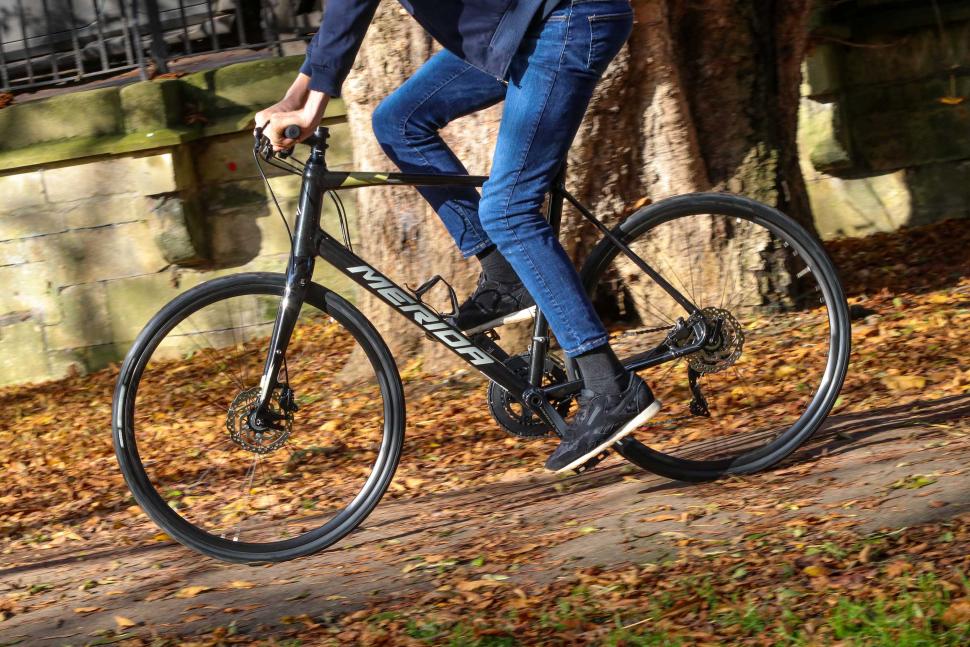
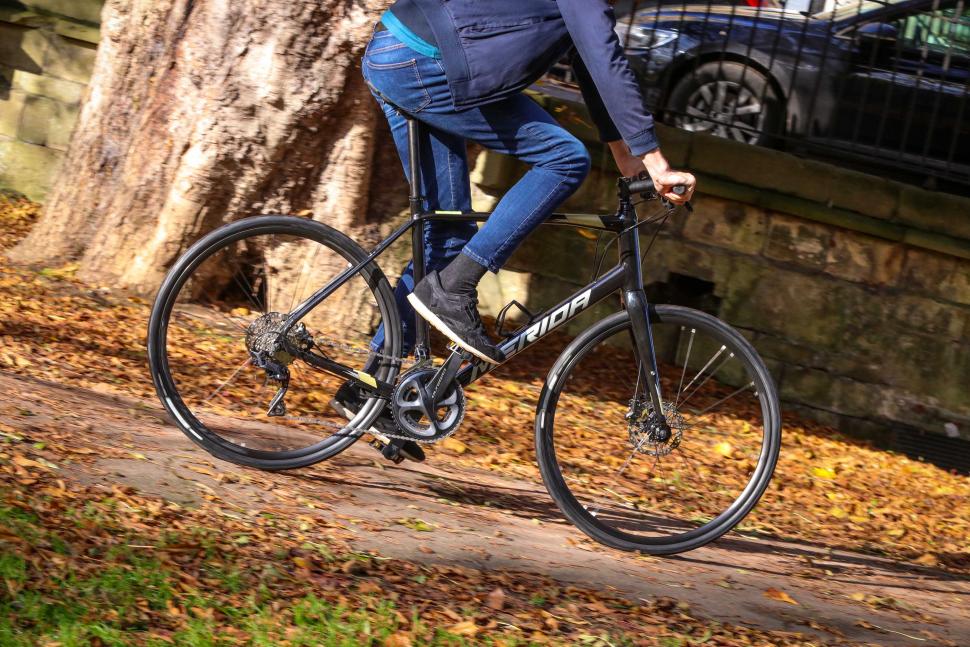

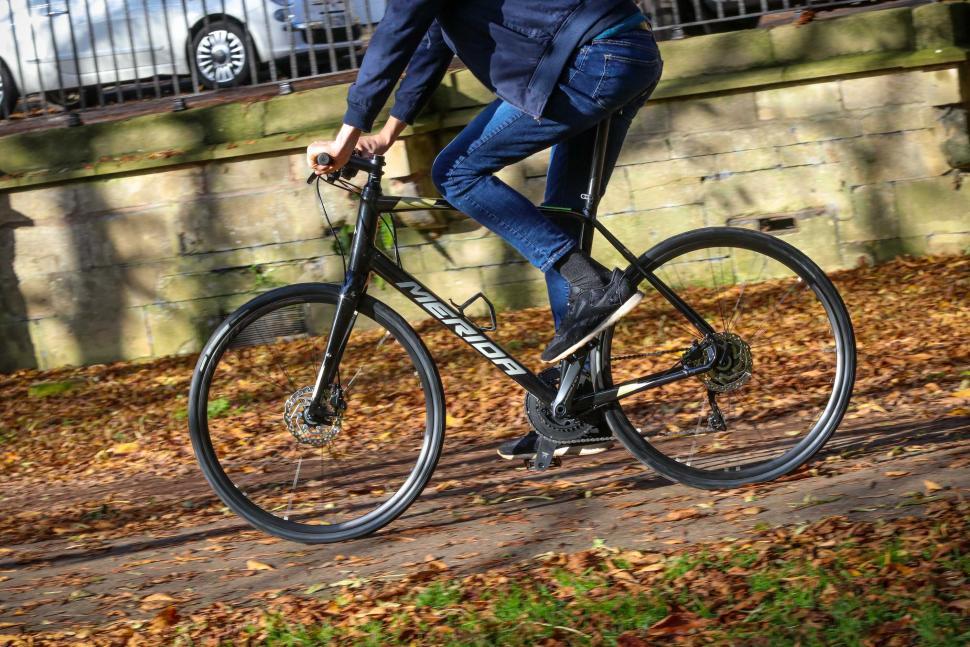
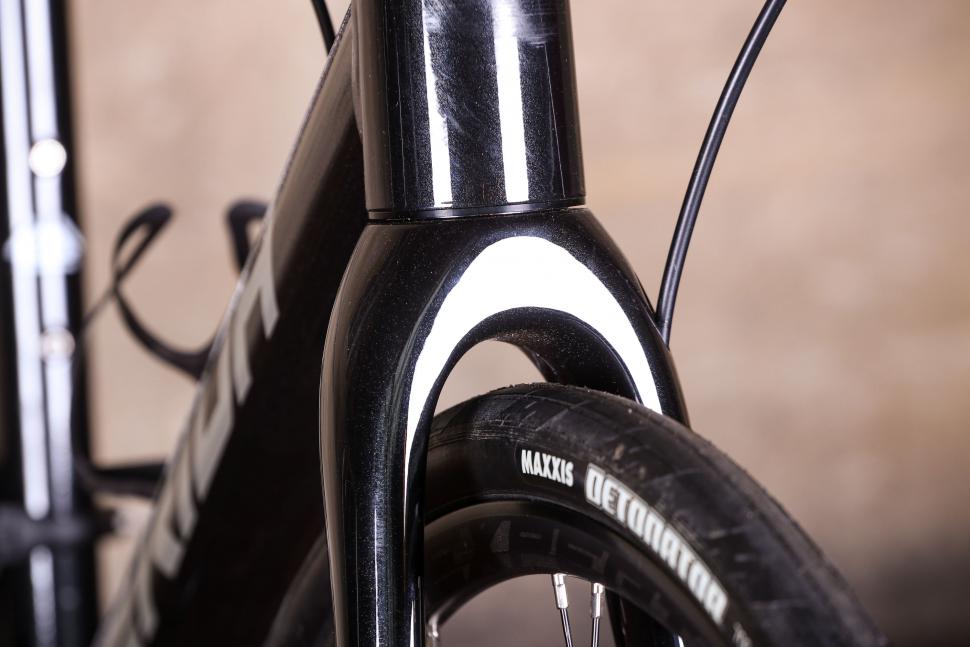
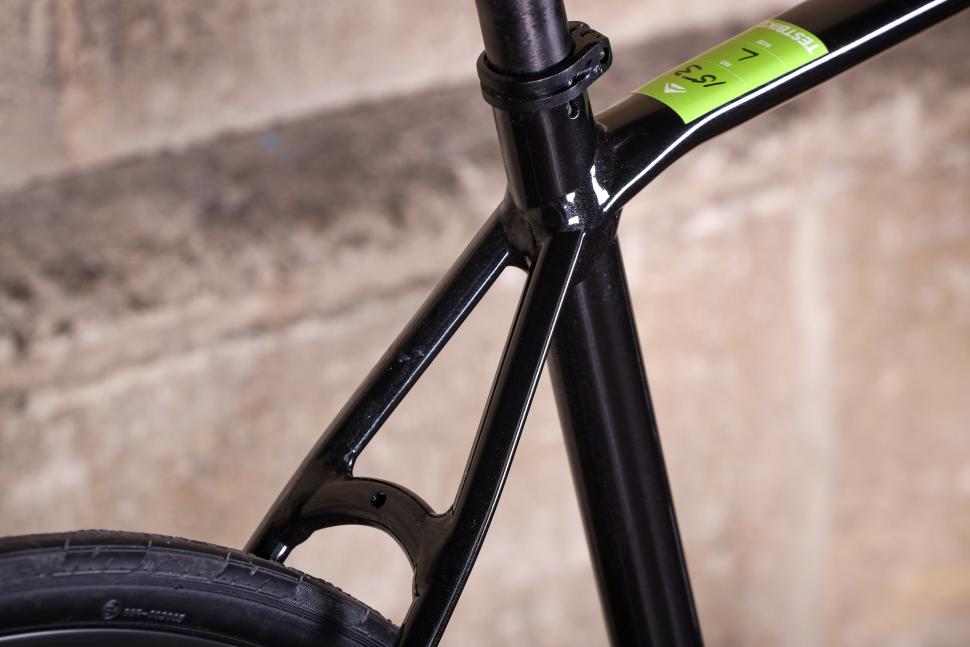
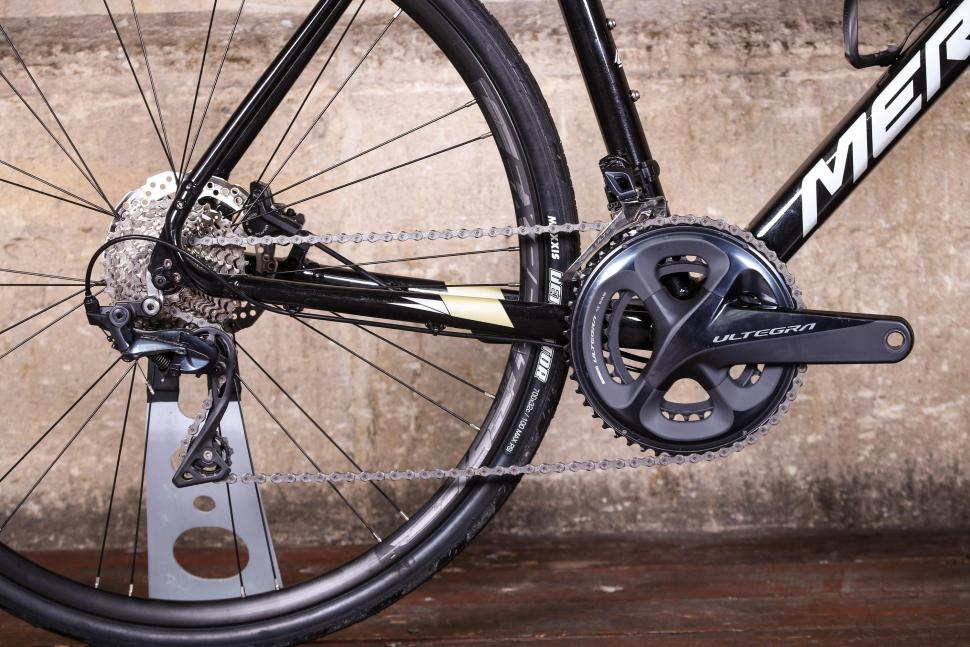


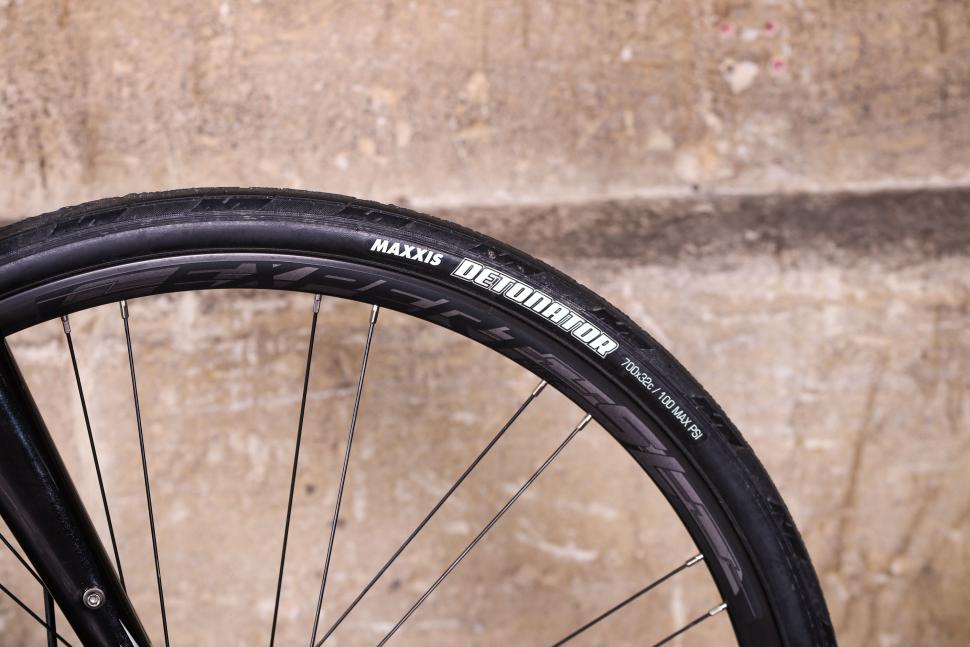

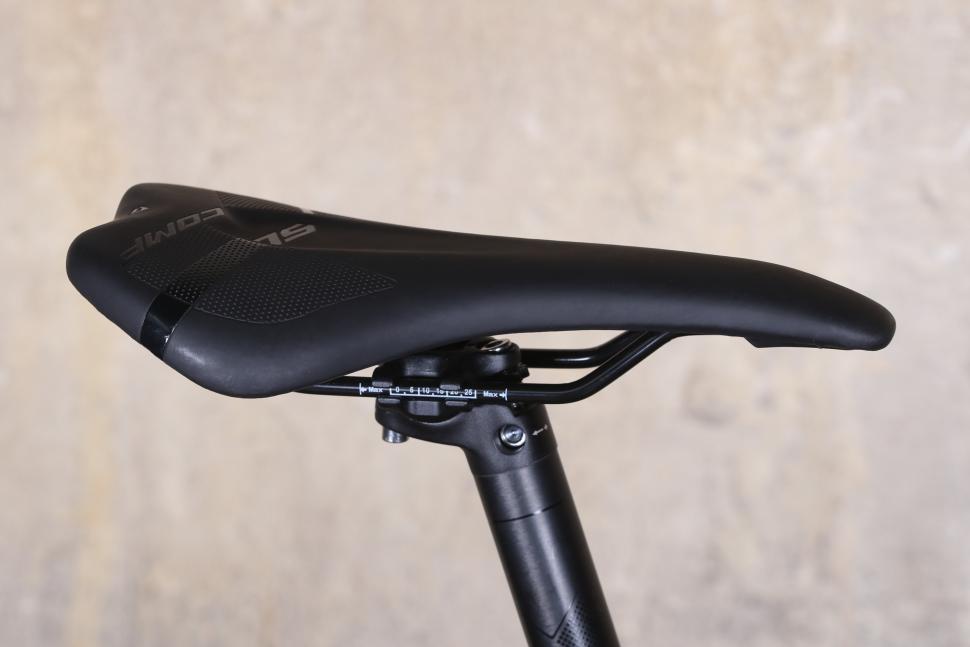
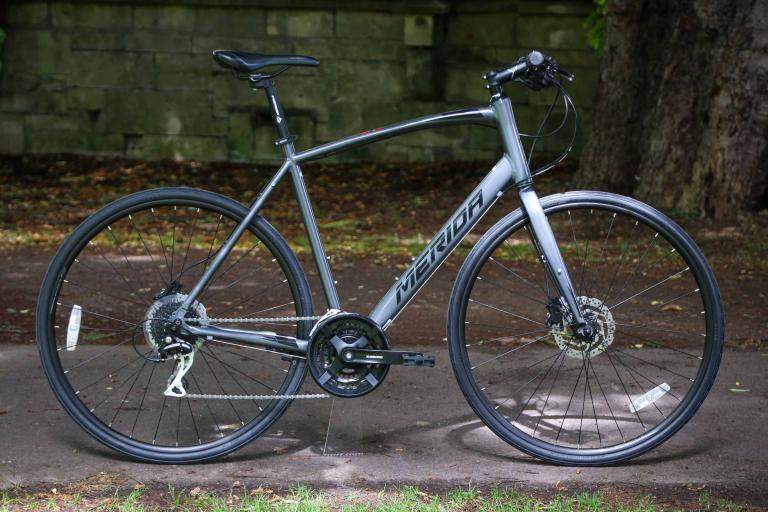
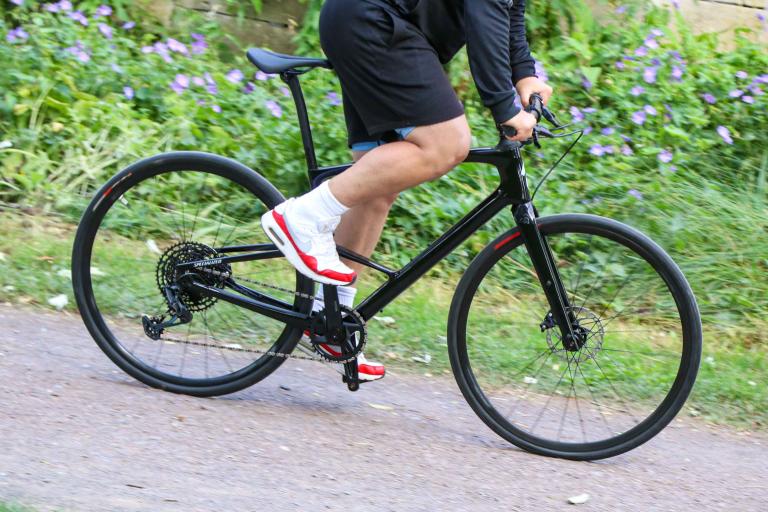
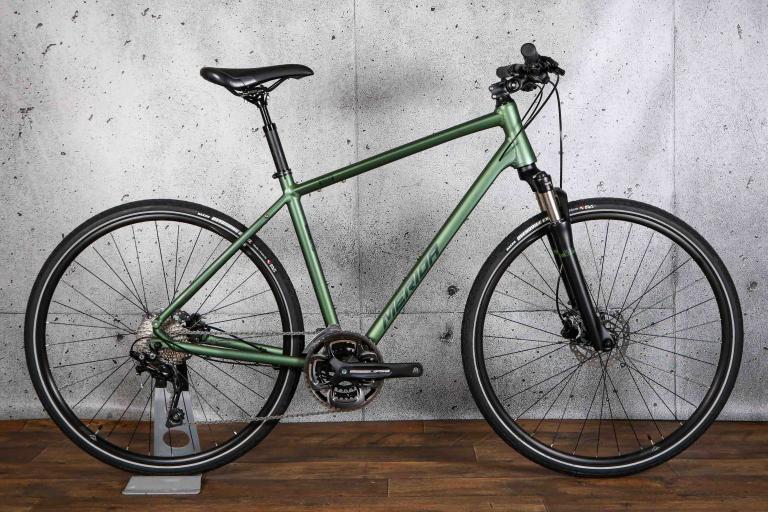
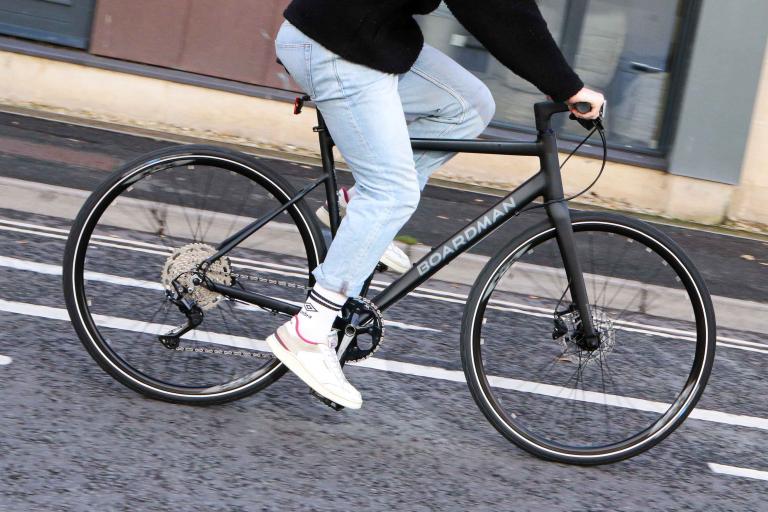
Add new comment
11 comments
Hi fellow two wheel fanatics,
Greetings from Belgium.
Reading the article about the Merida Speeder 900 made me enthousiastic.
I am a novice when it comes to bikes, I currently have the Decathlon Triban RC500.
Can one compare the Merida with this bike or is the Merida a class of its own?
Thank you for your feedback.
"Because they can be pumped up to 100psi, it means you have exactly the same contact patch with the road as skinnier tyres at 100psi......."
No you don't, you have a shorter, wider contact patch.
"..........yet enjoy just a little more comfort."
No you won't, the extra comfort from fatter tyres is largely due to the lower pressure you can run at.
"But with a bit of dampness on the floor, and maybe some slidey surface mulch, you'll want to swap to something with a bit more bite because these lose grip very quickly in poor conditions."
Or you could run the tyres a a pressure more suited to them so they don't lose so much grip.
I see a pinarello locked up at work occasionally. I'll leave them a note next time, tell them it's a bit much.
People, cyclists included, have lots of things they don't 'need'. If someone wants a nice bike for their commute, and has secure parking, why not?
100psi in 32mm tyres is crazy though and possibly distorts the entire review, specially for the tyres.
I know a couple of people who do club rides on flat bar bikes due to medical issues with areas such as their backs meaning they cannot use drop bars.
Otherwise I agree, no one ever needed Ultegra for the commute!
Struggling to see what this bike do for. It's not a road bike. It's overkill as a commuter.
My high school physics might be a bit shady here, but wouldn't 100psi in a 32mm tyre be LESS comfortable than 100psi in a smaller tyre?
100psi applied to the larger internal area of the 32mm tyre would equal a greater overall force, so the tyre wouldn't deflect as well over the bumps?
I run 32s at 50psi for my 85kg bulk, only one pinch flat to date...
Did you check if those rims were rated to withstand 100 psi with a 32 mm tire mounted?
It's not because the tires say they can that your rims will take that pressure. Most rims are only rated to about 60-70 psi when used with a 32 mm tire. Going higher is playing with fire.
And as was said, I can't imagine needing that much pressure anyway.
Clue's in the tyres' name, "Detonators"!
Lol. I bought a Whyte a long time ago that came with Maxxis Detonators. They were thin for a commuter bike and punctures ensued.
"Because they can be pumped up to 100psi, it means you have exactly the same contact patch with the road as skinnier tyres at 100psi, yet enjoy just a little more comfort."
You were pumping 32mm tires up to 100psi? No wonder they didn't feel great...
According to the chart road.cc have posted before you'd need to weigh an awful lot to need anywhere near that much!
https://road.cc/content/feature/180830-how-choose-your-tyre-pressure-bal...